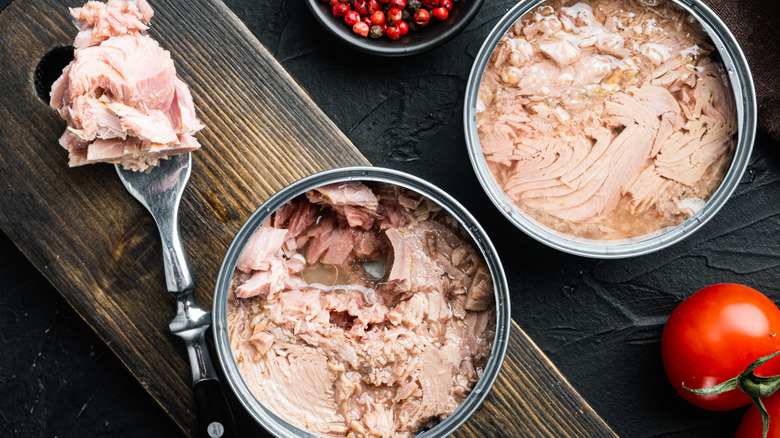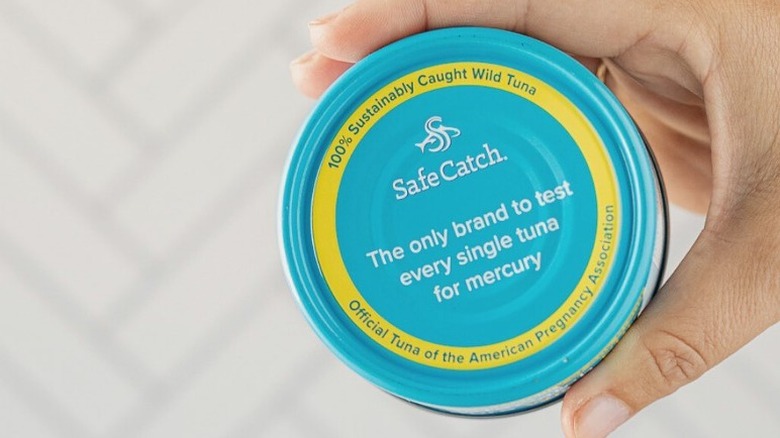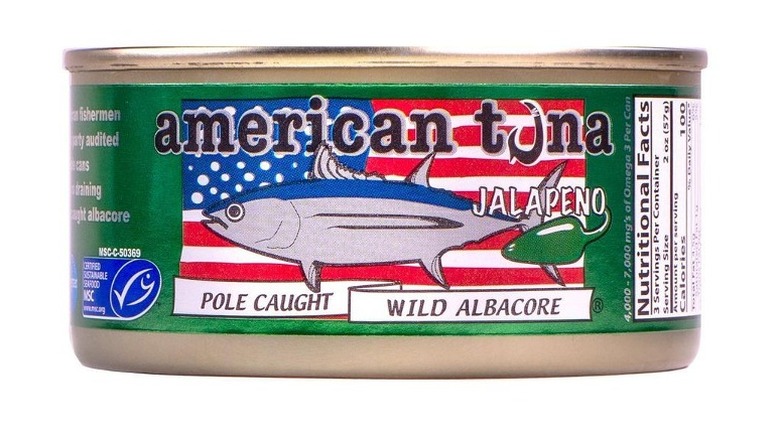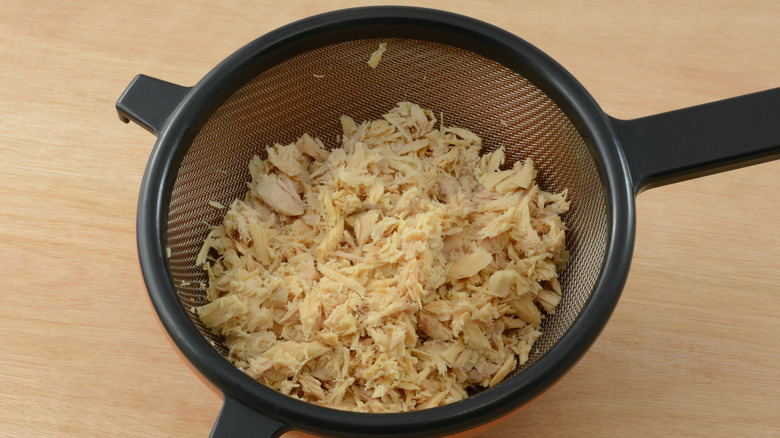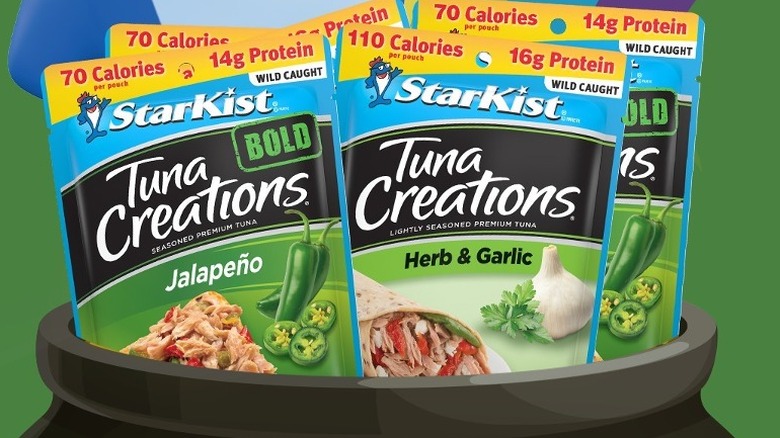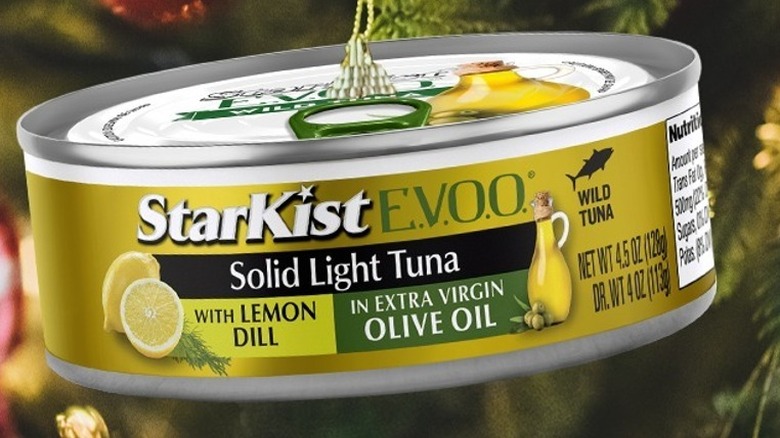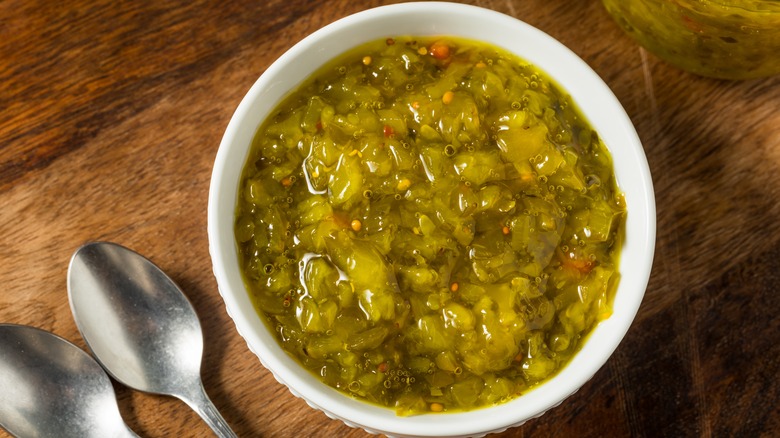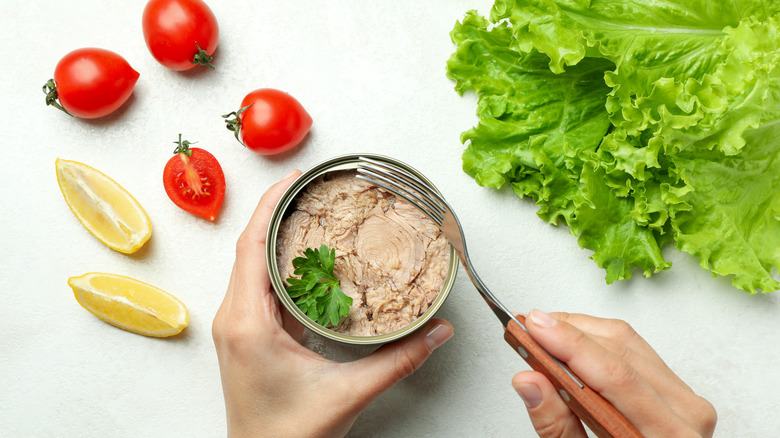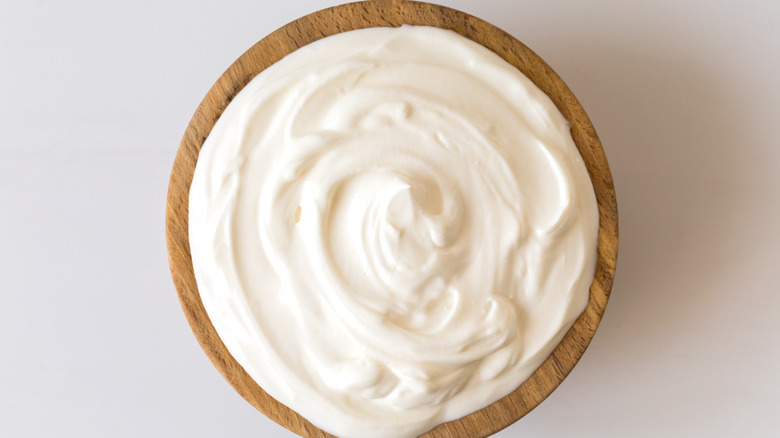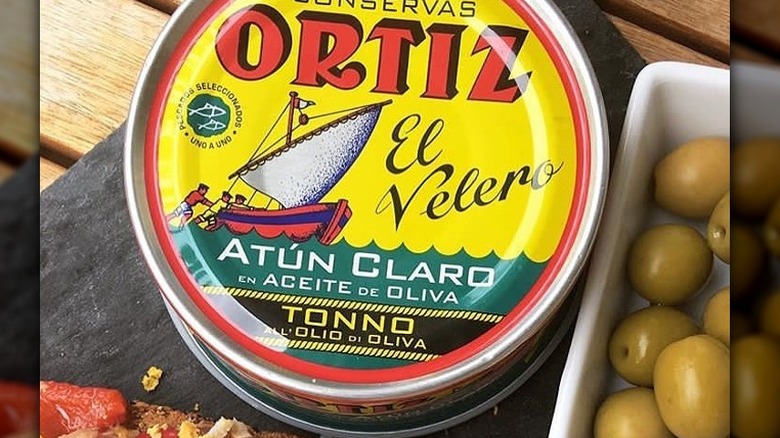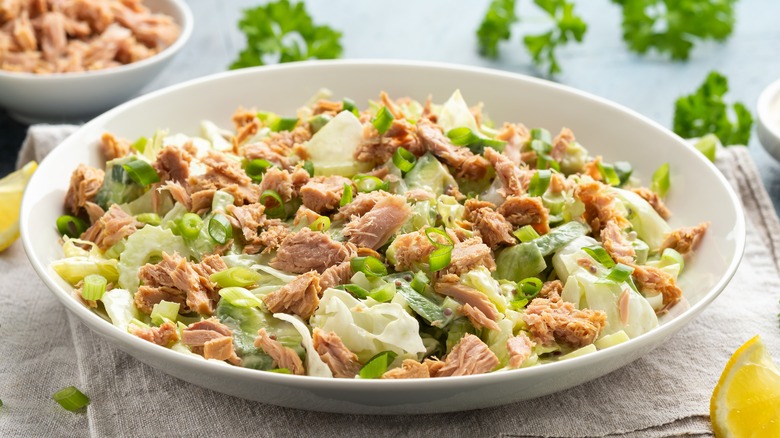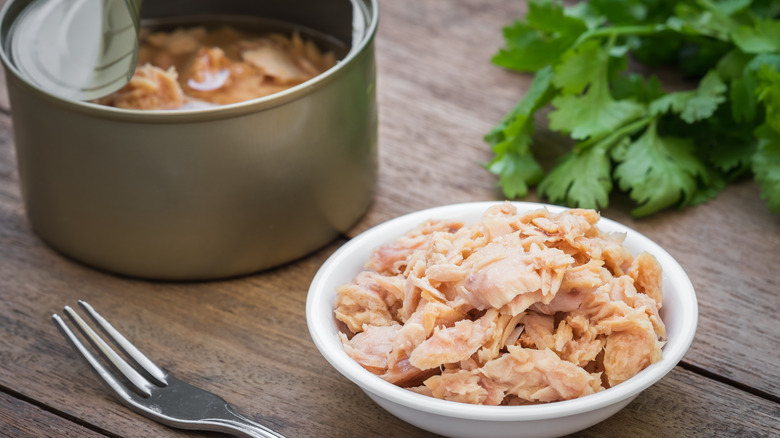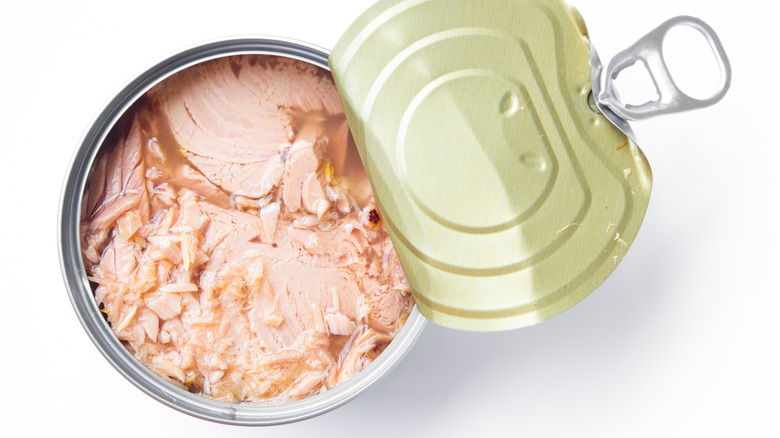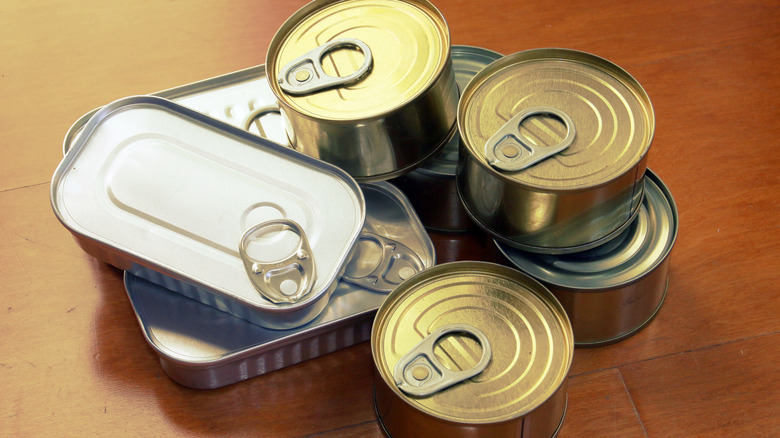14 Mistakes You're Making With Canned Tuna
Ingredients like bread, butter, and eggs are such constants in the kitchen that we stop paying attention to them. The humble can of tuna belongs at the top of this list. No matter whose kitchen you're in, you're bound to find at least a can or two hidden in the back of a cupboard.
We keep it around for those days when we just can't muster up the energy to cook. Every time, it dutifully complies, providing us with an easy and tasty meal. It's true, tuna has come through for us more times than we can count. That's why it pains us to admit that we don't always give it the respect it deserves (and you probably don't, either). Well, no longer. Starting right now, let's treat canned tuna better. Step one? Reading this article and learning some mistakes you're making with canned tuna. In addition to buying and storing tips, we provide recipe ideas to make you see this true-blue kitchen staple in a new light.
Not looking for reduced mercury options
When you're rushing to make a sandwich between Zoom calls, thinking about the amount of mercury in your tuna is probably the last thing on your mind. We know you're busy, so allow us to resume what we know. Mercury is a heavy metal found in air, water, and soil. It's toxic to humans. More specifically, consuming more than the Environmental Protection Agency's (EPA) reference dose of 0.045 mcg of mercury per pound of body weight per day on a regular basis can damage the brain and nervous system. This may look like a loss of motor function, muscle weakness, or the feeling of pins and needles in the extremities.
While consuming a can of tuna once a week is perfectly safe, there are other things you can do to reduce your risk of mercury exposure. Avoid buying albacore tuna and opt for light or skipjack varieties, instead. On average, the EPA notes that albacore tuna has three times the amount of mercury as these other types. Another option is to buy from brands like Safe Catch that test the mercury levels in every single can of tuna.
Failing to select sustainable tuna
We hate to be a buzzkill, but if you're not buying sustainable tuna, there's a good chance other animals were harmed or killed alongside the tuna. Commercial fishing practices require fishermen to cast large nets into the water, capture the tuna inside, and hoist the catch out of the water. This technique is efficient but leads to a lot of unintended injuries and deaths. Aside from tuna, other fish and dolphins get tangled in the nets. Instead of getting cast back into the ocean, they end up dead.
Fortunately, it's not all bad news. These days, plenty of tuna brands use more humane and sustainable fishing practices. Some of these brands include American Tuna, Wild Planet, and Whole Foods 365. You can find a full list of sustainable canned tuna brands on Seafood Watch's website. Alternatively, look for terms like dolphin safe, pole caught, or school caught on tuna cans. You can feel confident that the tuna came from an environmentally friendly fishery whenever you see these terms.
Storing tuna cans improperly
The whole point of buying canned tuna is to chuck it into your pantry for those just-in-case moments, right? Not so fast. While canned tuna is pretty resilient, lasting up to four years on average, it can't withstand everything. In particular, light, heat, and humidity can quickly degrade the quality of your canned tuna if you're not careful.
Light is dangerous to tuna because it can accelerate the corrosion process. In the best-case scenario, that means your tuna will have a nasty metallic taste to it. In the worst-case scenario, it becomes tainted and unsafe to eat. Heat is dangerous to canned tuna because it causes premature spoilage. That's especially true when stored above 100 degrees Fahrenheit. That may sound extreme, but even temperatures above 75 degrees Fahrenheit can lead to some loss of nutritional value. Ideally, you should store your tuna between 50 degrees Fahrenheit and 70 degrees Fahrenheit. In addition to protecting your cans from heat or light, you should do your best to control the humidity level. Prolonged exposure to water leads to rusting. Rust can cause cans to rupture, making them unsafe to eat. To ensure your tuna stays as fresh as possible, store it in a closed cupboard or pantry away from a stove, furnace, or hot water pipe.
Not draining the can completely
We're not saying you don't know how to remove liquid from a can of tuna, but we are asking you to consider the possibility that your technique could use a little work. But before we share our tuna-draining hacks, why is it so important to drain cans of tuna? There are more reasons than meet the eye. The most obvious one is that it makes your tuna salad better. If you don't remove all of the liquid, your sandwich will become a watery mess instead of a lunchtime delight. Besides that, removing the liquid can also reduce the amount of sodium in the can, if that's what you're looking for.
Now that you've got a better understanding of why draining canned tuna is so important, here are the three best techniques for eliminating that pesky liquid. Option one involves opening the can just a bit, turning it upside down, and allowing the liquid to spill out. The second option is similar, except this time you remove the entire lid, place it over the tuna, then press down to remove the liquid. Finally, you can pour the tuna into a colander and press down on it to squeeze out the liquid.
Only buying plain canned tuna
Chances are, you don't put a whole lot of thought into what kind of tuna you're buying. After all, its role is mostly to serve as an inexpensive, easy, and relatively tasty pantry staple. That's all well and good, but if you're sticking solely to the plain variety, you're missing out on the magical world that is flavored tuna.
You might have glimpsed a few basic flavors like roasted garlic or lemon and thyme while browsing the canned fish aisle at the supermarket, but the options are truly endless if you open your eyes. For example, StarKist Tuna's options allow you to go on a culinary trip around the world, just by opening a package. This leading tuna brand makes everything from Thai chili and spicy Korean with gochujang to jalapeño and honey barbecue. With flavors this bold and diverse, you'll wonder why you ever spent so much time eating bland tuna.
Ignoring oil-packed tuna
If you're anything like us, you probably grew up hearing that oil-packed tuna was full of fat, calories, and sodium. Chances are, you carried those beliefs with you into adulthood and have never risked buying the oil-packed variety. While it's true that water-packed tuna has less than half the calories as the oil-packed variety, it has far less flavor. Tuna packed in oil has more selenium and vitamin D than its watery counterpart.
Nutrition aside, oil-packed tuna is also the superior option when it comes to cooking certain dishes. When you want the flavor of the tuna to stand out, the richness of oil-packed tuna can't be beaten. For that reason, consider using oil-packed tuna on top of green salads or when adding to pasta dishes. Alternatively, you can use it when making Ina Garten's signature tuna melt. Garten prefers oil-packed tuna for the simple recipe, claiming that the tuna stays moister thanks to the oil.
Skipping sweet relish for tuna salad
It sounds unusual, but adding a sugary ingredient to canned tuna tones down the fishiness, making it more palatable for those who a less than enthusiastic about seafood. One option is to add white sugar to canned tuna. You don't need much to notice the difference. Just ½ a teaspoon of sugar for three 5-ounce cans is all you need to transform this staple food into a gourmet delight.
If the thought of adding sugar to canned tuna makes your stomach curl, consider mixing sweet relish into your fish, instead. Sweet relish contains fishiness-neutralizing sugar, plus it provides a satisfying bit of crunch to your sandwich. To take things even further, you can eliminate the mayonnaise entirely and just use sweet relish as a tuna salad binder. We understand that you might still be on the fence, so consider this — plenty of fish-based recipes contain sugar. For example, look at tazukuri (Japanese candied sardines), or Filipino sweet pusit adobo (a squid dish containing soy sauce and sugar).
Not adding enough ingredients
We get it — the whole reason you're making tuna salad is that you want to eat something satisfying that doesn't require a load of chopping or boiling. But on those days when you've got a bit more energy, give your lunch a glow-up by adding some ingredients to your tuna salad. They're nothing fancy, but they take your tired sandwich and turn it into something wow-worthy.
A squeeze of fresh lemon juice is an easy starting point. Fresh citrus does double duty when it comes to improving canned tuna. Not only does it brighten up the blandness, but it also helps counteract some of the brininess tuna is known for. Hot sauce is another way to inject some life into your fish. Obviously, it provides some heat, but many varieties also contain vinegar, an ingredient that adds just the right amount of tanginess. We're also big fans of adding soy sauce to tuna salad. Adding just a few teaspoons gives your canned tuna a burst of umami goodness.
Only using mayonnaise as a binder
Mayonnaise and canned tuna go together like peanut butter and jelly, but it's not the only option out there when it comes to holding your flaky fish together. There are dozens of mayo swaps, but they all have one thing in common — they'll give your tuna salad an entirely new flavor profile.
Kewpie mayonnaise, a popular Japanese condiment made with egg yolks, gives your tuna salad a satisfying touch of umami richness. On top of that, it contains rice or apple cider vinegar, ingredients that provide a pleasant tang. Looking for a lighter mix-in with more substance? Then consider using Greek yogurt in place of mayonnaise. Greek yogurt has a similar flavor and consistency to mayo, but it has more protein, making it an easy substitute. Tzatziki is another Greek-inspired mayo swap that provides creaminess and crunch. Travel a bit father for Middle Eastern-inspired tuna salad made with hummus or labneh, a creamy yogurt cheese similar to Greek yogurt.
Neglecting gourmet options
Tuna's price tag is one of its biggest selling points, but what if we told you that investing a few dollars more per can would drastically improve your eating experience? Per-can prices of gourmet canned tuna start at $3 per can and go up from there. That might be enough to give you sticker shock and run back to your beloved StarKist but hear us out.
Gourmet tuna brands like Ortiz, Genova, and Scout offer tuna that's thicker, more tender, and more flavorful than the average grocery store variety. Oftentimes, the fish is marinated or oil-packed, leading to a moister, more complex tuna-tasting experience. Besides their superior flavor profiles, many of these gourmet brands offer something cheaper brands don't — a commitment to sustainability. As an example, Ortiz's tuna is pole-and-line-caught. Using this centuries-old technique takes longer, but it means that few, if any, other fish are harmed in the process.
Using it only for sandwiches
We're not statisticians, but we're willing to estimate that pretty much all canned tuna ends up mixed with mayonnaise, nestled between two slices of bread. There's absolutely nothing wrong with the humble tuna salad sandwich, but relegating this versatile ingredient to just sandwiches is one of the biggest mistakes you can make with canned tuna. We've got about a thousand canned tuna recipes, but here are just a few of our favorites.
Tuna lettuce wraps are a ridiculously easy way to upgrade your tuna sandwich recipe. Make tuna salad as you normally would, adding onions, celery, or any other fresh herbs you desire. Scoop about ½ a cup of the finished product into a butter lettuce leaf, roll it up, and enjoy. For a crave-worthy appetizer, try tuna croquettes. To make them, mix tuna, egg, and breadcrumbs, then fry until golden brown. Or you can try Chef Tom Colicchio's favorite canned tuna recipe. He combines tuna with sliced fennel, bitter greens (endive radicchio), and vinaigrette to create a healthy version of the lunchtime classic.
Tossing the oil
You're probably so used to peeling the lid off of a can of tuna and letting the oil drip down the drain that you could do it with your eyes closed. But what if we told you that you're discarding something valuable? That's right, not only is leftover oil from canned tuna a super versatile ingredient, but it's completely free. Talk about a win-win.
Salad dressing is an easy way to use up canned tuna oil. Combine it with vinegar, Dijon mustard, salt, and pepper to make a fast and healthy vinaigrette. It's also a great addition to Caesar salad dressing, as the tuna-infused oil pairs well with the anchovies in the recipe. Beyond that, you can use tuna oil to dress cold pasta salad or use it as a dipping sauce for bread. Feel free to use it for frying eggs or sautéing fish. We could go on, but we think you get the picture.
Storing leftover tuna in the can
Technically speaking, there's nothing wrong with storing leftover tuna inside its own can. Sure, there's a small risk of the Bisphenol-A (BPA) from the can's lining seeping into your food, but you'd have to eat several cans worth of tuna to even come close to the European Union's maximum recommendation of 0.2 nanograms per kilogram of body weight per day. So if storing tuna in its can isn't a health concern, why should you avoid it?
Taste and smell are the two main reasons. Tuna left in an open container is exposed to air, something that dries it out and causes it to absorb the flavor of the can. We don't know about you, but dry, metallic tuna doesn't sound all that appetizing. In terms of smell, an open container of tuna will leave behind a trail of fishiness that may take weeks to clear out of your refrigerator. On top of that, there's a chance that the fishy odor could taint the flavors of other items in your refrigerator. Storing leftovers in a sealable plastic or glass container is the best option, but if you can't be bothered, then at least cover the can with some plastic wrap.
Keeping canned tuna too long
With an average shelf life of three to five years, canned tuna is one of the longest-lasting food items in your cupboard. But just because you can keep it for years doesn't mean it never goes bad. The easiest way to ensure you're eating the freshest tuna possible is to check the expiration date. You don't have to obey it to the day but try to use up any old cans within a few months of the deadline.
Beyond that, you should check the outside of the can for damage. Here, we're talking about things like dents, rust, bulges, and leaks. As long as they're small (not large enough to fit a finger into), dents aren't a reason to toss your tuna. If your cans have big gouges, take a good whiff before eating to make sure the tuna hasn't gone off. Rusty, bulging, or leaky cans are more problematic, as this kind of damage could indicate the presence of clostridium botulinum bacteria, a toxin that could make you sick or even kill you. The risk is low, but it's just not worth taking the chance.
